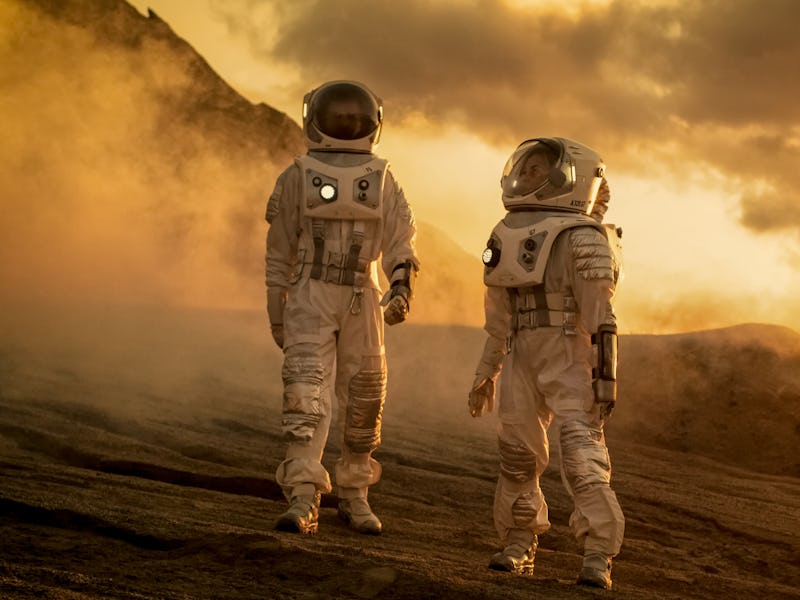SpaceX Crew Dragon astronaut says 3 factors need to align to get to Mars
Doug Hurley, along with Bob Behnken, is about to fly to the International Space Station using a SpaceX Crew Dragon capsule.

Getting humans to Mars is going to require the species to work together in a wide variety of ways.
NASA astronaut Doug Hurley is set to make history this month, when he launches into space alongside Bob Behnken inside a SpaceX Crew Dragon capsule. The mission, set for May 27, will be the first time SpaceX has sent humans to the International Space Station, and the first time since 2011 that NASA has sent astronauts into space from the United States.
Both NASA and SpaceX have spoken about their aims to spark a new era of space exploration, returning humans to the moon, establishing permanent bases, and even sending humans to Mars.
Speaking with Inverse ahead of the launch, Hurley says that achieving these breakthroughs will require collaboration between the private sector, the public sector, and international players:
"To do great things in space, going outside of low-Earth orbit, going to the moon, going to Mars, venturing out into the solar system, I think absolutely it's going to be a combination of the public and private sector in order to be able to accomplish that. There's just too much work. Flying in space is expensive, to a degree, depending on your point of view, and just the innovation and the agility a private company can offer, I think adds a huge amount of capability to be successful in those types of missions. And not only public and private but an international aspect of it as well."
The mission is the culmination of years of development. SpaceX and Boeing are both NASA partners on the Commercial Crew program, aimed at developing a capsule that can ferry humans to and from the space station. Ever since NASA's shuttle program ended in 2011, the agency has been using seats on Roscosmos' Soyuz rockets flying from the Baikonur Cosmodrome in Kazakhstan.
Beyond bringing the flights a bit closer to NASA, the flight also paves the way for more ambitious missions. SpaceX is developing the Starship, and NASA the SLS, with a view to sending humans to Mars. Hurley says that to reach these Mars missions, it's going to require big collaborations.
"That all needs to happen, those types of collaboration need to happen for us to venture out into the solar system. Certainly to go to Mars, as a species, is going to most likely involve all those entities."
Behnken (left) and Hurley get to grips with the Crew Dragon's controls.
Flying the Crew Dragon – Hurley has experience with flying a range of craft. He served as a test pilot in the United States Marine Corps, before being selected as an astronaut in 2000. Hurley has been on two spaceflights before: the STS-127 shuttle mission in 2009, and the STS-135 mission in 2011, the shuttle's final mission.
Crew Dragon is fitted with a slew of touchscreens, and SpaceX's suits look set to impress. But Hurley, who is in charge of launching, landing and recovery, explains how it's not just surface-level differences with his previous experience.
"In this case it's quite a bit different because, from an entry perspective, a capsule, as well as shuttle, you adjust the heat shield such that it absorbs the plasma as you're re-entering, and that is done automatically by Crew Dragon. Shuttle was also automatic for the most part, but we could fly it manually in the phase of flight as well. And then we have some ability, depending on if there are certain failures, to be able to deploy the chutes manually, both the drogues and the main. But with a capsule landing in the water, obviously the precision of where you're landing is not quite as great as it was with the shuttle where you absolutely needed to land on a runway, and a big runway at that."
Behnken and Hurley during training.
Although the capsule is designed to autonomously dock with the space station, Hurley says the team has to remain alert to take over if necessary.
"Sitting in the commander seat, for Dragon, you're responsible all the way to that thing is docked with the station. Every phase of flight. Bob and I have trained a while with this vehicle, and that's our responsibility, to monitor and if it's available to take over manually if it's not going in the way it's supposed to."
When the pair arrive at the space station they will be staying for an extended period, before returning to Earth after an as-yet undecided length of stay. When they return, they will have provided SpaceX and NASA with reams of data that could prove vital for future missions to the likes of Mars.
It may seem like one small trip to the space station, but it could represent one giant leap for manned spaceflight.